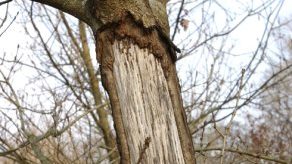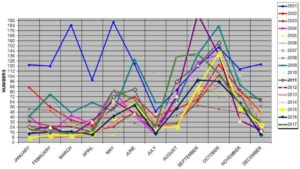Counting the Cost of Squirrel Control in an Oak Plantation
It is not possible to produce first rate timber from oak and other broadleaved species in Britain and Ireland without systematic grey squirrel control.

Sotterley Estate, Beccles, Suffolk
172 hectares broadleaved woodlands aged 0 to 175 years, with around 90% dedicated to oak over hornbeam and hazel.
Production of high quality oak timber within a traditional landscape setting. Care is taken to enhance habitats for plants, insects and birds.
Timber crops
The Estate has adopted Lemaire’s “active” silviculture with the aim of reducing the time taken to produce marketable oak timber, currently 150 years. (See Oak: fine timber in 100 years.)
From age 15 and for the next 30 years, oak is vulnerable to attack by grey squirrels which strip the bark often girdling the stem. This causes the top to die or be deformed reducing the potential value of the tree from veneer worth £400 or planking quality worth £300 to firewood worth £40 per cubic metre.
Systematic grey squirrel control
It is not possible to produce first rate timber from oak and other broadleaved species in Britain and Ireland without systematic grey squirrel control.
It spends nearly £10,000 per annum on grey squirrel control. Most of this cost is the daily labour required to visit 125 Fenn Mark 4 traps set in wooden tunnels.
About 700 animals are killed each year at a cost of £14 per animal. Dreys are destroyed in February.
The graph, below, updated from a version published in Charles Dutton’s The Grey Squirrel Management Handbook, shows the two peak periods of culling; May when the first litter is weaned and September when weaners from the second litter invade from neighbouring uncontrolled countryside.

The results
It is extremely rare to find any damage. Very occasionally, hornbeam and beech have been attacked but these were spotted almost immediately and corrective measures taken.
For the last 25 years Sotterley Estate has avoided any damage to oak.
The future
There is no future for timber production from young broadleaved trees in Britain and Ireland under present conditions because the high cost of controlling grey squirrels prevents most woodland owners from protecting their trees.
New technology such as immuno-contraception (IMC) has the potential to remove grey squirrels from Britain and Ireland. This will make possible the successful production of valuable timber and the return of red squirrels to the woods from which they were driven.
The RFS is an active member of the UK Squirrel Accord.
For our policies on grey squirrel control visit

